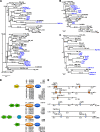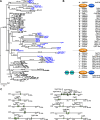Phylogenetic analysis of the caspase family in bivalves: implications for programmed cell death, immune response and development
- PMID: 33494703
- PMCID: PMC7836458
- DOI: 10.1186/s12864-021-07380-0
Phylogenetic analysis of the caspase family in bivalves: implications for programmed cell death, immune response and development
Abstract
Background: Apoptosis is an important process for an organism's innate immune system to respond to pathogens, while also allowing for cell differentiation and other essential life functions. Caspases are one of the key protease enzymes involved in the apoptotic process, however there is currently a very limited understanding of bivalve caspase diversity and function.
Results: In this work, we investigated the presence of caspase homologues using a combination of bioinformatics and phylogenetic analyses. We blasted the Crassostrea gigas genome for caspase homologues and identified 35 potential homologues in the addition to the already cloned 23 bivalve caspases. As such, we present information about the phylogenetic relationship of all identified bivalve caspases in relation to their homology to well-established vertebrate and invertebrate caspases. Our results reveal unexpected novelty and complexity in the bivalve caspase family. Notably, we were unable to identify direct homologues to the initiator caspase-9, a key-caspase in the vertebrate apoptotic pathway, inflammatory caspases (caspase-1, - 4 or - 5) or executioner caspases-3, - 6, - 7. We also explored the fact that bivalves appear to possess several unique homologues to the initiator caspase groups - 2 and - 8. Large expansions of caspase-3 like homologues (caspase-3A-C), caspase-3/7 group and caspase-3/7-like homologues were also identified, suggesting unusual roles of caspases with direct implications for our understanding of immune response in relation to common bivalve diseases. Furthermore, we assessed the gene expression of two initiator (Cg2A, Cg8B) and four executioner caspases (Cg3A, Cg3B, Cg3C, Cg3/7) in C. gigas late-larval development and during metamorphosis, indicating that caspase expression varies across the different developmental stages.
Conclusion: Our analysis provides the first overview of caspases across different bivalve species with essential new insights into caspase diversity, knowledge that can be used for further investigations into immune response to pathogens or regulation of developmental processes.
Keywords: Apoptosis; Bivalves; Caspase; Inflammation response; Innate immune system; Programmed cell death; Pyroptosis.
Conflict of interest statement
The authors declare that they have no competing interests.
Figures




Similar articles
-
Identification and functional characterization of two executioner caspases in Crassostrea gigas.PLoS One. 2014 Feb 13;9(2):e89040. doi: 10.1371/journal.pone.0089040. eCollection 2014. PLoS One. 2014. PMID: 24551213 Free PMC article.
-
New insights into the apoptotic process in mollusks: characterization of caspase genes in Mytilus galloprovincialis.PLoS One. 2011 Feb 11;6(2):e17003. doi: 10.1371/journal.pone.0017003. PLoS One. 2011. PMID: 21347300 Free PMC article.
-
The Caspase Homologues in Scallop Chlamys farreri and Their Expression Responses to Toxic Dinoflagellates Exposure.Toxins (Basel). 2022 Jan 31;14(2):108. doi: 10.3390/toxins14020108. Toxins (Basel). 2022. PMID: 35202135 Free PMC article.
-
Expansion and diversity of caspases in Mytilus coruscus contribute to larval metamorphosis and environmental adaptation.BMC Genomics. 2024 Mar 27;25(1):314. doi: 10.1186/s12864-024-10238-w. BMC Genomics. 2024. PMID: 38532358 Free PMC article. Review.
-
Caspases - an update.Comp Biochem Physiol B Biochem Mol Biol. 2008 Sep;151(1):10-27. doi: 10.1016/j.cbpb.2008.05.010. Epub 2008 Jul 3. Comp Biochem Physiol B Biochem Mol Biol. 2008. PMID: 18602321 Review.
Cited by
-
Thyroid hormone-induced cell death in sea urchin metamorphic development.J Exp Biol. 2022 Dec 1;225(23):jeb244560. doi: 10.1242/jeb.244560. Epub 2022 Dec 1. J Exp Biol. 2022. PMID: 36412991 Free PMC article.
-
Design and synthesis of new trimethoxylphenyl-linked combretastatin analogues loaded on diamond nanoparticles as a panel for ameliorated solubility and antiproliferative activity.J Enzyme Inhib Med Chem. 2022 Dec;37(1):2679-2701. doi: 10.1080/14756366.2022.2116016. J Enzyme Inhib Med Chem. 2022. PMID: 36154552 Free PMC article.
-
A new type of Caspase-1 upon recognizing bacteria inhibits GSDME-dependent histone modification and NF-κB signaling.Commun Biol. 2025 May 29;8(1):827. doi: 10.1038/s42003-025-08290-7. Commun Biol. 2025. PMID: 40442231 Free PMC article.
-
Expansion of the HSP70 gene family in Tegillarca granosa and expression profiles in response to zinc toxicity.Cell Stress Chaperones. 2024 Feb;29(1):97-112. doi: 10.1016/j.cstres.2024.01.004. Epub 2024 Jan 24. Cell Stress Chaperones. 2024. PMID: 38272254 Free PMC article.
-
Effects of HMGA2 gene silencing on cell cycle and apoptosis in the metastatic renal carcinoma cell line ACHN.J Int Med Res. 2022 Feb;50(2):3000605221075511. doi: 10.1177/03000605221075511. J Int Med Res. 2022. PMID: 35118889 Free PMC article.
References
-
- Gerdol M, Gomez-Chiarri M, Castillo MG, Figueras A, Fiorito G, Moreira R, et al. Immunity in molluscs: recognition and effector mechanisms, with a focus on bivalvia. In: Cooper E, et al., editors. Advances in comparative immunology. Cham: Springer; 2018. pp. 225–341.
-
- Sokolova I. Apoptosis in molluscan immune defense. Invertebr Surviv J. 2009;6(1):49–58.
MeSH terms
Substances
Grants and funding
LinkOut - more resources
Full Text Sources
Other Literature Sources
Research Materials

